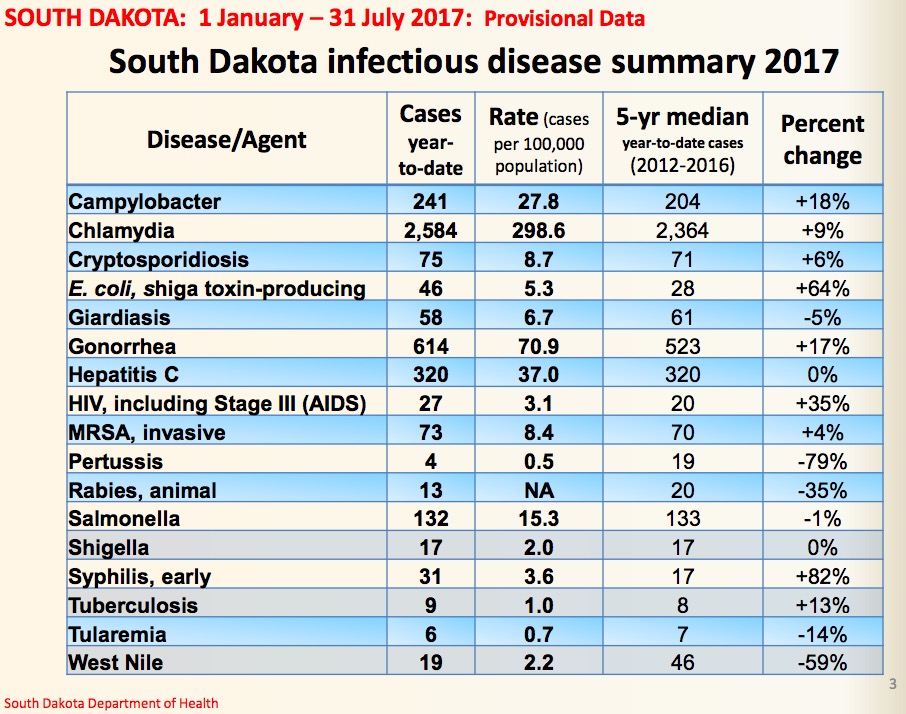Keep it zipped, Sturgis Rally-goers: you’re a lot more likely to get gonorrhea or chlamydia from your new South Dakota friends than you are to catch West Nile from our mosquitos.
According to the South Dakota Department of Health’s July 2017 report, so far this year, South Dakota has reported 19 cases of West Nile, 614 cases of gonorrhea, and 2,584 cases of chlamydia.
West Nile cases are down 59% so far this year. Also down are rabies, tularemia, giardiasis, and (just barely) salmonella, all of which Rally-goers could conceivably get while out camping, and pertussis, which doesn’t strike me as a camping-related affliction. Alas, syphilis is up 82%, E. coli infection by 64%, and HIV by 35%. Gonorrhea is up 17% and chlamydia by 9% from already high rates. Hepatitis C is holding steady with 320 cases so far this year.
The Department of Public Safety does not count infectious diseases in its daily Sturgis Rally Tally. But hey, bikers—love the one you’re with, but love carefully… and wash your hands.
Related: Rabid animals across South Dakota so far this year: six skunks, two bats, two cows, one goat, one cat, and one raccoon. No dogs! SD-DOH also provides the cutest map of pathology I’ve ever seen showing rabid creatures by county in 2016:

Three cats, just one dog… but all those bats! Yikes!

I’m thinking mosquitoes are more discerning who and what they snuggle up with than your ordinary, everyday hawg rider. I was gonna say biker but I didn’r my cyclists such as Master and friends.
One of the surest ways to stay healthy is to make sure your “biking” involves moving your feet in circles.
Since we’ve already established the Sturgis Rally is really a trailer convention for Baby Boomers, and when you look at SD Dept of Health data, Gonorrhea & the clap are predominantly experienced in those under age 40. They’re also highest in a handful of counties – our two most populated (Minnehaha and Pennington) and in counties which have tribal reservations.
The incidence data bears out that STDs are highest in blacks (significantly so, at near 500 per 100k) and AI populations (at near 200 per 100k), and lowest in Asians & whites.
This public health crisis is silently being borne predominantly in our immigrant communities in Sioux Falls, and our tribal populations. It’s something we shouldn’t make light of.
When I first moved out to SD, I saw STD statistics showing my new state ranking near the top compared to national avg.
Ever since, as a single guy, I have noticed that the vast majority smart and -simultaneously- attractive women remotely close to my age bracket have already moved away to where they can a.) find better professional opportunities for themselves or b.) find themselves a husband who makes better money, and who’ll fully provide them a high quality of life.
So, as a smart, good looking -lol- single guy in his mid 30s, who’s still 100% clean of STDs, when I look around, I have barely ever run across a datable woman. I assume the SD ladies in my age bracket have most-all had sex with someone – who had sex with someone – who had sex with someone – who had sex with someone – who is/was careless about who they’ve had sex with in the past – and ya know what? I’m right. It’s right there in the population health statistics.
Obviously, it’s not just the ladies, but I’m not interested in men, so I’ve just been paying attention to the ladies in the dating dept. If they ain’t cool with a blood test, then they be dirty!
If anyone knows a nice, cute, smart, clean single gal in her 30s-ish, in the RC area, I’m happy to buy her dinner. Oh yeah, she can’t be a Trump voter! That’s REALLY IMPORTANT too. LOL
Wayne, interesting point about where STDs are happening. Note that the July 2017 report shows numbers and rates for regions of of the state, and rates for gonorrhea and chlamydia are higher in the West, Rapid City, and Central regions than in Sioux Falls. That might require at least a minor revision of your sentence to place the SF immigrant population second in your list of at-risk populations, if not further down absent further detailed information.
Adam, I’ve often thought about target-poor environment for singles in South Dakota, but never in the context of STD rates. I can see your problem—smart datable prospects moving away—being compounded by the fact that many of the people who move back here to replace our brain drain are parents coming to raise their kids in the perceived safety of small-town South Dakota. But dang—then their kids don’t get comprehensive sex ed and are thus at greater risk of getting STDs.
Cory, the order of my list wasn’t meant to imply quantity – it was keeping consistency from the prior paragraph. Blacks had the highest rate, and Minnehaha County has the highest concentration of blacks due to African refugees. However, since they’re such a small percentage of the population (less than 3% compared to the 18% AI population), they account for fewer overall cases of STDs.
However, given those demographics, education programs should be aimed in culturally-appropriate ways to those demographics to help bring them in line with the rest of the population.
Reasonable. We should get preventive education measures wherever they are needed. Even so, rates are still higher in other areas, and the higher prevalence among blacks appears not to have broken out of racial/cultural confines yet in the Sioux Falls metro.